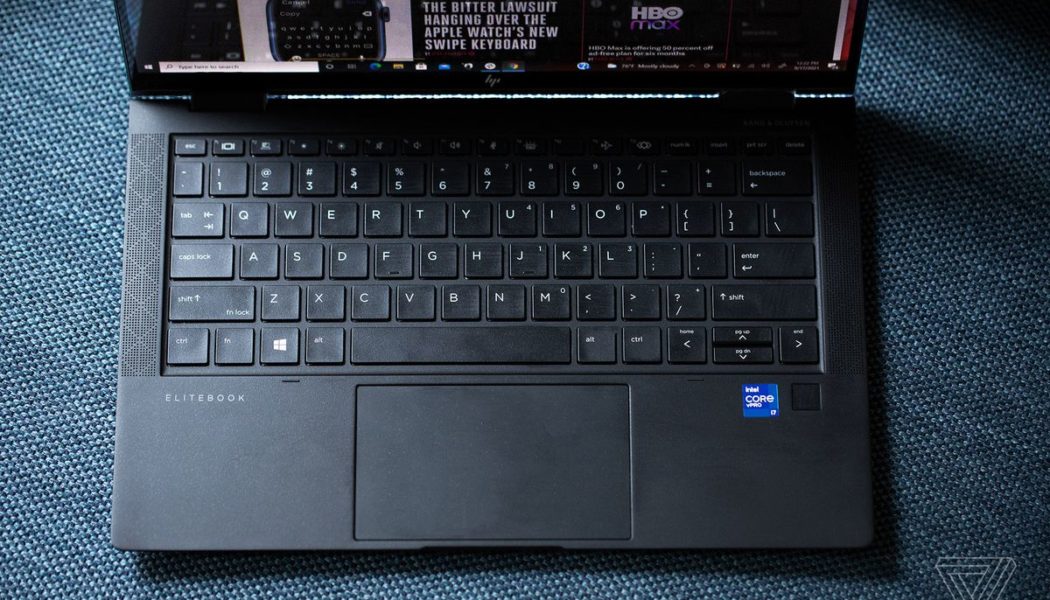HP’s Elite Dragonfly Max is the nicest business laptop I’ve ever used. That doesn’t mean it’s the best, all things considered — when it comes to performance, battery life, and features, the Dragonfly has fierce competition from the Latitudes and ThinkPads of the world. But there’s no business laptop out there that matches the elegance of a Dragonfly. It’s a sleek, light, and beautiful computer — and that beauty is a big part of its hefty, hefty price tag.
Right, the price tag. Before we get into this: The cheapest Dragonfly Max has an MSRP of $3,347 (currently listed at a still-expensive $2,409.84). You can buy my test model for, oh, a discounted price of just $2,622.24. That puts the Dragonfly Max out of reach for most people. And frankly, given the device’s small but noteworthy list of drawbacks, I do think it’s too high. But it’s a gorgeous laptop, it’s really fun to use, and it’s a great case study in the very peak of what a laptop can be.
There are two Elite Dragonfly models you can currently buy: the Dragonfly Max, and the Dragonfly G2. Both have been upgraded to 11th-Gen Intel processors and DDR4 memory — HP tells me they’re aimed at “mobile users who loved Dragonfly, but want an even faster and smarter device”. There are some new smart features including AI noise reduction for video calls, and new security features like a tamper lock. The Dragonfly Max adds an upgraded 5MP camera, an extra microphone, a blue light shield, a new black color, and a few extra security features.
The other noteworthy difference is that the Dragonfly G2 has a variety of different configurations: You can choose between five processors, three displays, two batteries, and various types of storage, as well as a number of add-ons, and prices are all across the board. You can make a few adjustments to the Dragonfly Max, but its options are much more limited — two processors, one screen, one battery. It’s targeting a very specific deep-pocketed business user.
:no_upscale()/cdn.vox-cdn.com/uploads/chorus_asset/file/22864079/akrales_210917_4733_0085.jpg)
:no_upscale()/cdn.vox-cdn.com/uploads/chorus_asset/file/22864073/akrales_210917_4733_0033.jpg)
:no_upscale()/cdn.vox-cdn.com/uploads/chorus_asset/file/22864072/akrales_210917_4733_0013.jpg)
One thing to note: all Dragonfly Max models come with Sure View Reflect, one of the Dragonfly line’s biggest calling cards. SureView reflect is a privacy screen that makes it very difficult for potential snoops to see what you’re doing. It’s optional on the G2, and costs an extra $145 over the standard display.
If you’re not buying the Dragonfly for its suave design, you’re buying it for Sure View Reflect. I’ve tested a few different privacy screens, and Sure View Reflect is hands-down the best one. If I moved my head a bit to the side, or angled the display slightly up or down such that I wasn’t facing it head on, I basically couldn’t make out any of its contents. Someone sitting next to me on a train or even peering over my shoulder would’ve had trouble gleaning any info. It’s an impressive feature, and doesn’t visibly impact screen brightness or glare much at all. (Of course, if you’re in a situation where you’ll be collaborating or moving your head around a lot, you can always turn the feature off.)
Sure View aside, the Dragonfly Max’s touch display is quite accurate and vivid, and delivers a whopping 1,000 nits of brightness — a number that’s unusual for anything that’s not a devastatingly expensive business laptop to reach. (Enabling Sure View will dim the display, of course.) It’s compatible with HP’s Wacom AES 2.0 pen, which is (frustratingly) not shipped with the device, as it did with previous Dragonfly generations. It costs an extra $74.
I do have a couple other complaints. For one, the screen is 16:9, which is falling out of fashion on expensive laptops for a reason. Lenovo has adopted the roomier 16:10 and 3:2 aspect ratios on a number of its premium ThinkPads, and HP should do the same with the Dragonfly. Both offer more vertical space and a more comfortable multitasking experience. Additionally, the screen picks up fingerprints and smudges very easily, and they weren’t trivial to wipe off. These aren’t as visible as they would be on a dimmer screen, but they did cheapen my viewing experience a bit.
The other reason you might want the Max over the G2 is its upgraded camera. The Dragonfly Max has a 5MP webcam with a separate infrared sensor. Webcams are often a weak point of otherwise-stellar laptops, and this webcam certainly improves upon the likes of the MacBook Air. It does a better job in low light than I’m used to seeing from webcams, and colors were fairly accurate. Coworkers on a Zoom call remarked that they could make out surprisingly minute details of my feed: strands of hair, my nose stud, etc. Of course, that doesn’t mean it delivers a great picture — my picture was a bit washed out with the light from my window, and there was still noticeable noise. It’s a good experience, but not something I’d buy the Dragonfly Max just to get.
The webcam also has a physical shutter that’s easy to click back and forth (though it’s tiny and black, so finding it takes a bit of guesswork). The separate IR sensor means Windows Hello facial recognition works even when the shutter is closed. You can also sign in with the fingerprint reader located below the right arrow key, which didn’t give me any trouble.
Paired with the webcam are four microphones (two front-facing and two back-facing) with AI noise cancelation. These picked up my voice just fine in video conferences, and can be killed easily with the F8 key.
:no_upscale()/cdn.vox-cdn.com/uploads/chorus_asset/file/22864076/akrales_210917_4733_0055.jpg)
HP continues including sustainable material in its high-end laptops, though its current pronouncements are slightly more conservative than they have been in past years. As was the case on the first-gen Dragonfly, the keyboard is made from 50 percent PCR DVDs, and 80 percent of mechanical parts are recycled material. The Max’s bezels are 45 precent post-consumer recycled (PCR) plastics and five percent ocean-bound plastics — the early-2020 Dragonfly’s bezels were 35 percent PCR plastic. But some of the Max’s other pronouncements are a bit of a step down from the previous Dragonfly. The speaker enclosures are 45 percent PCR plastics and five percent ocean-bound plastics, while the previous Dragonfly’s speaker box was 50 percent PCR plastics and five percent ocean-bound plastics. And 90 percent of the Dragonfly Max’s cover is recycled magnesium, while the previous Dragonfly’s entire chassis was 90 percent recycled. Still, it’s nice to see HP pursuing sustainability with its high-end lines.
The good news for shoppers, though, is that the recycled materials do nothing to cheapen the chassis. The Dragonfly Max has a smooth and comfortable texture, and feels quite sturdy. It has a striking, premium look rivaled only by HP’s own Spectre line in recent months. A hallmark of cheap plastic is that it accumulates fingerprints very quickly, but the Dragonfly remained smudge-free after over a week of testing. (The lid picked up a few, but they were only visible under bright light and were easily wiped away.)
:no_upscale()/cdn.vox-cdn.com/uploads/chorus_asset/file/22864074/akrales_210917_4733_0042.jpg)
Open the device up, and you’ll find a dizzying list of security features targeting C-suites and IT departments. New to these Dragonfly models is a tamper lock, which is meant to detect when a potential hacker has popped the chassis open to fiddle with components — if this occurs, the PC will require a BIOS password to be entered before it boots again.
Within the OS is Sure Click, a secure browser that opens websites within a CPU-isolated virtual machine. That means any malware you pick up while using Sure Click will be isolated from the rest of your system, and will disappear when you close the browser. It also offers protected viewing for PDFs and Office documents. I dinked around with it, and it was very easy to use, and conveniently ported over all my bookmarks. It has a slightly different color scheme from regular Chrome, so I never mixed up my tabs.
The device comes preloaded with a laundry list of other software. There’s Sure Sense, which scans every file you download for malware, and can detect “zero day never-before-seen threats”, per HP. There’s Sure Run, which keeps crucial processes running if malware tries to shut them down. There’s Easy Clean, which can temporarily disable the Dragonfly’s keyboard, touchscreen, and touchpad so you (or someone else) can wipe it down without accidentally booting it up. And there’s a Tile tracker inside, which you can use to locate the Dragonfly Max if you lose it via Tile’s massive crowd-finding network. It’s easy to set up and use, especially if you already have a Tile account.
:no_upscale()/cdn.vox-cdn.com/uploads/chorus_asset/file/22864071/akrales_210917_4733_0008.jpg)
Those are just the standout features of the Dragonfly Max — everything else about it is also hard to beat. It supports Wi-Fi 6 and optional 5G. It’s quite light, at just 2.49 pounds and 0.63 inches thick. The audio (via two upward-firing and two downward-firing speakers) is excellent, with bass and percussion that are audible, if not strong. The keyboard is a delight, with just the right amount of click and travel. There’s a surprisingly robust port selection for such a thin machine, including two Thunderbolt 4, one combo audio jack, one HDMI 2.0, one USB 3.1, one nano lock slot, and one nano SIM slot. And the chassis never got uncomfortably hot, nor were the fans ever loud.
The processor — a Core i7-1185G7 with support for Intel’s vPro, did a good job with all kinds of tasks, including heaps upon heaps of tabs and videos. I only saw a minor slowdown once, when I was using the Battery Saver profile and trying to jump between Slack and Chrome while running a Zoom call in the background. Switching off Battery Saver nipped that in the bud. Intel’s Iris Xe integrated graphics can lend a hand in GPU-intensive tasks or games like Overwatch, though you wouldn’t want to use the Dragonfly as a primary gaming device.
Battery life, though, was my biggest disappointment. I took the Dragonfly Max through my normal workday, juggling around a dozen Chrome tabs with some Spotify or YouTube streaming and Zoom calls on medium brightness with Battery Saver on, and it lasted an average of seven and a half hours. That result was remarkably consistent within 20 or so minutes, regardless of battery profile or what I did with Sure View. That’s not a devastating result, and it means the Dragonfly Max can make it through close to a full day if your workload is similar to mine. But it’s disappointing considering the competition — I got over 11 and a half hours out of the previous Dragonfly, and the Dell Latitude 9420 broke 10 while on the Battery Saver profile. And, of course, all kinds of more affordable consumer laptops can last much longer.
:no_upscale()/cdn.vox-cdn.com/uploads/chorus_asset/file/22864075/akrales_210917_4733_0046.jpg)
The Dragonfly is a great machine to buy, if you can afford it. I especially don’t begrudge IT departments for taking a look — businesses often buy these things in bulk and aren’t paying full price. Almost every aspect is good, and there are features you really can’t get anywhere else. If you’re looking for a combination of an embedded Tile tracker, an effective privacy screen, a 2.49-pound chassis, and a 5MP webcam with a separate infrared sensor, the Dragonfly Max is basically your only option.
But given how much money HP is asking for this thing, I can’t help but look at even mild drawbacks with a fairly critical eye. I don’t need a laptop to be completely flawless in order to recommend that you spend over $2,400 on it (or upwards of $3,000, depending on the day) — I’m willing to forgive a squeaky keyboard or an oddly-placed port here and there. But I do need it to have all-day battery life. I need its screen not to be covered in smudges. In this year 2021, I need it not to be 16:9. And, yes, I probably do need it to ship with a stylus. For that reason, I think most consumers are probably better suited to the regular G2, which starts as low as $1,819 and is much more customizable.
The Max is a luxury product, at the end of the day. It’s not so much a pragmatic purchase (for most of us) as it is a proof of concept — what could a laptop be if money were no object? The answer, as it turns out, is: very nice, and very expensive.









